More News
Hamas Official Reveals Details Of Truce Agreement With Israel

Khalil al-Hayya, a senior Hamas leader said they are still waiting for Israel’s decision regarding a truce agreement on a ceasefire in Gaza and the exchange of hostages for Palestinian prisoners.
Al-Hayya said this on Tuesday evening in Beirut.
“We are still waiting for the response of the occupying forces with regard to the agreement on a humanitarian ceasefire,” said the Hamas official.
According to Hamas, the agreement provides for a five-day pause in fighting and the entry of hundreds of lorries with aid supplies into the Gaza Strip as well as the exchange of Hamas hostages for prisoners in Israel.
Israel has yet to agree to the deal, it said.
Hamas already sent its response to the “brothers” in Egypt and Qatar, who were now working on an agreement with “significant efforts,” he said.
There were now “decisive moments” ahead, he added.
In Egypt, government sources said on Tuesday evening, that there was also talk of a decisive phase.
After “tangible progress,” the talks are now “in the final phase,” according to officials in Cairo.
In Washington, earlier on Tuesday, U.S. President Joe Biden said a deal was “very close” for the hostages held by Hamas to be released soon.
“We could bring some of these hostages home very soon,” Biden said.
He added he did not want to get into the details, but “things are looking good at the moment.”
In its unprecedented terrorist attack on Israel on Oct. 7, Hamas kidnapped about 240 people to the Gaza Strip and killed 1,200 in the border region.
An air and ground offensive by Israel has killed some 13,000 people in Gaza, according to the Hamas-run Health Ministry.
Meanwhile, Israel’s far-right Security Minister Itamar Ben-Gvir has sharply criticised the possible truce agreement between the Palestinian Islamist Hamas movement and Israel.
Ben-Gvir said he was very concerned that the deal currently being discussed was a “very, very, very big mistake.”
Ben-Gvir recalled the so-called Shalit deal in 2011, when more than 1,000 Palestinian prisoners – including the head of Hamas in the Gaza Strip, Yahya Sinwar – were released in return for the Israeli soldier Gilad Shalit, who had been held hostage by Hamas for five years.
“Remember, we freed Gilad Shalit and let Sinwar and his friends out – and brought this suffering upon ourselves,” Ben-Gvir said.
The minister is not a member of the Israeli war Cabinet.
In recent days, Israeli, U.S., and Qatari officials have stated that progress was being made to reach a truce agreement.
Qatar has been a key mediator in the negotiations to free the captives in Gaza.
Despite ceasefire agreement talks, fierce fighting continued in the Palestinian territory.
The Israel Defense Forces (IDF) said on Tuesday morning that more than 250 Hamas sites in Gaza had been hit over the past day, including missile launch positions.
Rockets were fired towards Israel once again, triggering air-raid sirens in the city of Rishon LeZion, south of Tel Aviv and in several other locations, the IDF said.
There were no reports of damage or injuries.
Hamas and other Palestinian militants have fired thousands of rockets since the war began on Oct. 7.
Many rockets are intercepted by Israeli air defences and some fall short and land inside Gaza.
Since Israel’s ground operations began on Oct. 28, the number of launches has decreased significantly.
The ground offensive was progressing on Tuesday with the complete encirclement of Jabalia in northern Gaza.
Israel describes the densely populated area as a Hamas stronghold and has been conducting operations there for weeks.
The IDF said it was readying for “battle” in Jabalia, adding that it had targeted three Hamas tunnel entrances and killed a number of militants in recent hours.
Photo and video footage showed huge craters and destroyed houses.
Jabalia is home to the largest refugee camp in the Gaza Strip.
The UN says it is 1.4 square kilometres in size and has 116,000 registered refugees.
The UN Office for the Coordination of Humanitarian Affairs (OCHA) reported on Tuesday that thousands had to camp out in the open despite heavy rainfall because the emergency shelters in the relatively safer south were overcrowded.
Many had set up camp next to the shelters with the few possessions they had, hoping to be able to have access to food and drinking water.
According to estimates by the Palestinian statistics authority, 800,000 people were still in the embattled north at the end of last week.
Since then, tens of thousands have fled daily past Israeli military posts to the south.
Meanwhile, staff and equipment to establish a new field hospital have arrived in the Gaza Strip.
A total of 180 doctors and nursing staff as well as around 40 lorries with the necessary equipment travelled from Egypt to the Gaza Strip on Monday, OCHA said Tuesday.
The hospital is to be built in the city of Khan Younis in the south of the territory.
The Jordanian royal family is spearheading the effort.
The hospital will have 40 beds as well as an intensive care unit and surgical facilities.
It is the second Jordanian field hospital in the Gaza Strip.
After weeks of war, the hospitals still functioning in Gaza are overwhelmed by patients and suffering from severe shortages of fuel, food, and medical supplies.
Many have also come under attack from the Israeli military, which accuses Hamas of using the hospitals for terrorist purposes and of treating the civilians inside as “human shields.” (dpa/NAN)
Send Us A Press Statement Advertise With Us Contact Us
And For More Nigerian News Visit GWG.NG










